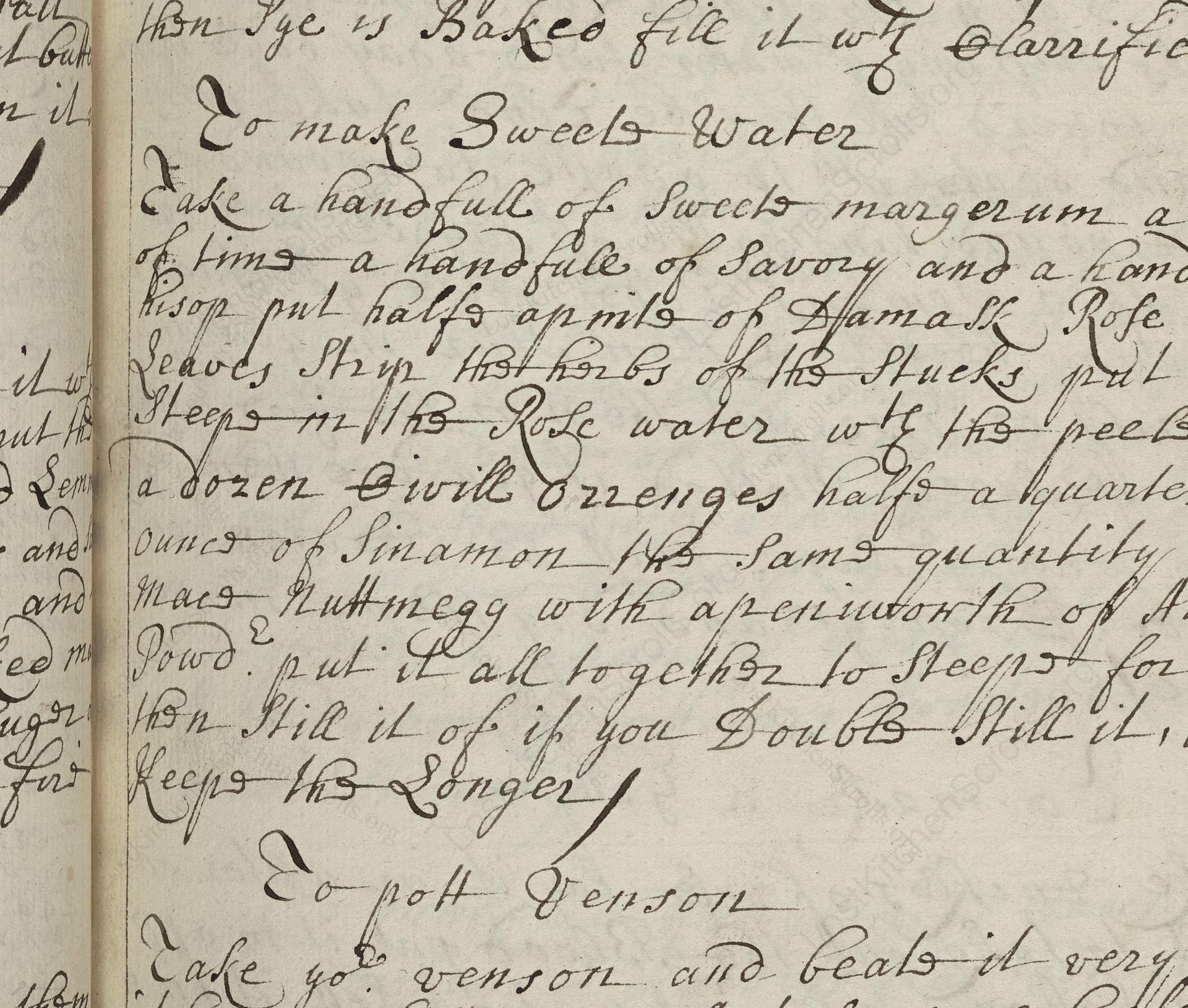To Make Sweets Water
From the treasured pages of Cookbook of Constance Hall
Written by Constance Hall

To Make Sweets Water
"Take a handfull of Sweets margerum a handfull of time a handfule of Savory and a handfule of hisop put halfe apinte of Small Rose water Leaves Strip the herbs of the Stucks put them to Steepe in the Rose water wth the peele of halfe a dozen Swill Orrenges halfe a quarter of an ounce of Sinamon the Same quantity of Cloves Mace Huttmegg with apeninoth of Arras Powd. put it all togther to Steep for a Night Then Still it of if you Doubt Still it it will Keepe the Longer"
Note on the Original Text
Seventeenth-century recipes were written with minimal punctuation and little standardization in spelling ('Stucks' for stalks, 'Huttmegg' for nutmeg, 'apinte' for a pint, 'apeninoth' for a pinch). Directions assumed a shared basic culinary knowledge and familiarity with the herb garden and apothecary. The text reflects an oral tradition, with measurements like 'handful' and 'pinch' rather than precise weights, inviting the cook to rely on experience and intuition. The spelling variations and irregular capitalization are typical of the era, preceding full standardization and the widespread availability of printed cookbooks.

Title
Cookbook of Constance Hall (1672)
You can also click the book image above to peruse the original tome
Writer
Constance Hall
Era
1672
Publisher
Unknown
Background
A spirited foray into 17th-century kitchens, this collection by Constance Hall brims with the flavors, secrets, and delicacies of Restoration-era England—perfect for cooks keen to revive a dash of history in their modern menus.
Kindly made available by
Folger Shakespeare Library
This aromatic concoction comes from a 1672 English household recipe book owned by Constance Hall. Sweets Water, or 'Sweet Water,' belonged to the tradition of scented waters and hydrosols highly prized in the 17th century, both for flavoring culinary delights and as a fragrant beverage or medicinal tonic. The inclusion of aromatic herbs, citrus peel, and spices, all steeped in rosewater and then distilled, reflects the period's fascination with both the exoticism of imported ingredients and the home-based alchemy practiced in genteel households.

Historically, this recipe would have been prepared using a mortar and pestle for bruising the herbs, a large stoneware or glass steeping vessel, and most notably, a copper alembic or simple still for distillation. The distillation process concentrated the flavors and preserved the water. For modern adaptations, a glass bowl for steeping and fine strainer or muslin cloth for filtering are sufficient; a small still or home distillation apparatus can substitute if one wishes to be authentic.
Prep Time
15 mins
Cook Time
5 mins
Servings
5
We've done our best to adapt this historical recipe for modern kitchens, but some details may still need refinement. We warmly welcome feedback from fellow cooks and culinary historians — your insights support the entire community!
Ingredients
- 0.7 oz sweet marjoram leaves
- 0.7 oz thyme leaves
- 0.7 oz savory leaves
- 0.7 oz hyssop leaves
- 8.5 fl oz rosewater (culinary grade)
- Peel of 6 Seville oranges (or standard orange peel)
- 0.25 oz cinnamon stick
- 0.25 oz whole cloves
- 0.25 oz mace
- pinch of nutmeg (about 0.04 oz, freshly grated if possible)
- pinch of orris root powder (substitute for Arras powder, optional)
Instructions
- To recreate Sweets Water in a modern kitchen, gather an abundant handful each of sweet marjoram, thyme, savory, and hyssop (about 0.7 oz each, leaves only).
- Strip the leaves from their stalks for best infusion.
- Add the fresh peel of six Seville oranges (or regular oranges if unavailable) to 8.5 fl oz of rosewater, making sure it's culinary grade and unsweetened.
- To this, add 0.25 oz of cinnamon stick, 0.25 oz of whole cloves, 0.25 oz of mace, and a pinch of nutmeg.
- Optionally, use a small pinch of powdered orris root (Arras powder isn't common today; orris root is a close substitute).
- Combine all the ingredients in a glass or non-reactive bowl, cover, and allow them to steep overnight at room temperature.
- For a more traditional finish, the mixture would then be distilled (using an alembic or small still); at home, this can be mimicked by gently warming the mixture and straining the infused liquid, which helps preserve its delicate fragrance.
Cooking Estimates
Preparation takes about 15 minutes as you'll strip leaves and peel oranges. Steeping is done overnight without effort. There is no cooking needed, unless you choose to gently warm the mixture, which takes about 5 minutes. This recipe makes about 250 ml of Sweets Water, or roughly 5 servings of 50 ml each. Since it's an infused water not consumed in large quantities, calories are nearly zero per serving.
As noted above, we have made our best effort to translate and adapt this historical recipe for modern kitchens, taking into account ingredients nowadays, cooking techniques, measurements, and so on. However, historical recipes often contain assumptions that require interpretation.
We'd love for anyone to help improve these adaptations. Community contributions are highly welcome. If you have suggestions, corrections, or cooking tips based on your experience with this recipe, please share them below.
Join the Discussion
Rate This Recipe
Dietary Preference
Main Ingredients
Culinary Technique

Den Bockfisch In Einer Fleisch Suppen Zu Kochen
This recipe hails from a German manuscript cookbook compiled in 1696, a time whe...

Die Grieß Nudlen Zumachen
This recipe comes from a rather mysterious manuscript cookbook, penned anonymous...

Ein Boudain
This recipe comes from an anonymous German-language manuscript cookbook from 169...

Ein Gesaltzen Citroni
This recipe, dating from 1696, comes from an extensive anonymous German cookbook...
Browse our complete collection of time-honored recipes



